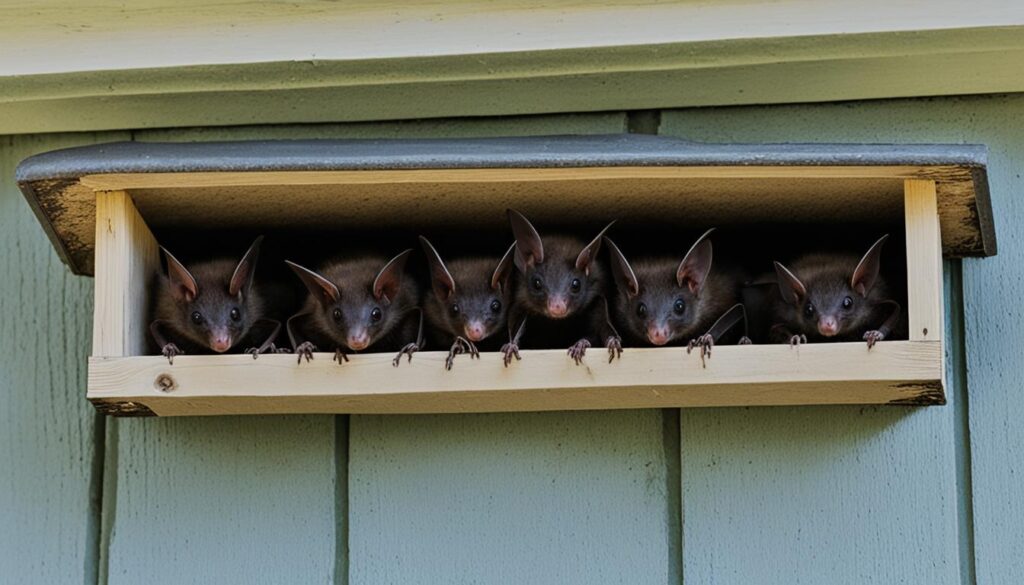Do you ever feel a chill down your spine when you hear faint flapping sounds at night? Or perhaps wake up to the unsettling sight of dark shadowy figures darting across your ceiling? For many of us, the presence of bats in our homes can evoke a deep sense of fear and unease. But fear not, as you are not alone in this unsettling encounter with these nocturnal creatures.
Bats, while fascinating creatures, can become a nuisance when they decide to make our homes their own. The key to dealing with this situation is to ensure safe bat removal, protecting both you and the bats themselves. In this article, we will guide you through effective methods to get rid of bats from your home while ensuring their safety.
Key Takeaways:
- Understanding the importance of safe bat removal methods
- Identifying common signs and indicators of bat infestations
- The benefits of professional bat removal services
- Natural remedies and deterrents to keep bats away
- Tips for excluding bats from your home and preventing future infestations
Understanding Bat Behavior
Before attempting to remove bats, it is crucial to understand their behavior and roosting habits. This knowledge will help you effectively address your bat infestation and implement appropriate solutions. So, let’s dive into the fascinating world of bat behavior.
Bat Roosting Habits
Bats are nocturnal creatures, which means they are most active at night. During the day, bats seek shelter in secluded areas, known as roosts, to rest and avoid predators. Understanding where bats roost is essential in identifying their presence in your home.
Bats have diverse roosting preferences, but common locations include:
- Caves and mines
- Attics and crawl spaces
- Tree hollows
- Under bridges and overpasses
- Structural crevices in buildings
It’s important to note that certain bat species have specific roosting requirements. For example, some species prefer warm attics, while others seek out tree cavities. By understanding these preferences, you can better identify potential roosting sites and devise effective removal strategies.
Bat Behavior Patterns
Bats exhibit fascinating behaviors that contribute to their survival and ability to navigate dark environments using echolocation. Some key bat behavior patterns include:
Bats use echolocation to navigate and find prey. They emit high-pitched sounds, which bounce off objects and return as echoes, helping the bats locate food sources and avoid obstacles.
Bats are highly social creatures and often form large colonies in their roosting sites. These colonies can consist of hundreds or even thousands of individuals, depending on the species. Understanding the social dynamics of bat colonies can help you adopt appropriate techniques for removal.
Many bat species are insectivorous, making them valuable for natural pest control. They feed on a variety of insects like mosquitoes, moths, and beetles. Preserving these natural pest control agents is vital to maintaining ecological balance.
Why Bats Are Attracted to Certain Areas
Bats are attracted to specific areas for several reasons:
- Food Availability: Bats are attracted to areas with abundant insect populations, such as near bodies of water or areas with dense vegetation.
- Safe Roosting Spots: Bats seek out roosting sites that offer protection from predators, excessive heat, and disturbances. Your home may provide favorable conditions for bats to establish their colonies.
- Accessible Entry Points: Bats can enter structures through small openings, sometimes as small as a quarter of an inch. Gaps in roofs, vents, and loose siding are potential entry points that attract bats looking for shelter.
Now that you have a basic understanding of bat behavior and roosting habits, you are better equipped to handle your bat infestation. In the next section, we will delve into how to identify signs of bat infestations, so you can take appropriate action.
Identifying Bat Infestations
When it comes to bat infestations, early detection is key to effectively addressing the issue. In this section, we will discuss the telltale signs that indicate the presence of bats in your home. By being able to identify these signs, you can take prompt action and prevent further damage to your property.
- Bat droppings: One of the most obvious signs of bat infestations is the presence of bat droppings, also known as guano. These droppings are often found in concentrated piles around roosting areas such as attics, crawlspaces, or walls.
- Urine stains: Another indicator of bat infestations is the presence of urine stains on walls, ceilings, or other surfaces close to their roosting sites. These stains may appear as dark, irregular-shaped marks.
- Strange odors: Bats emit a distinctive musky smell that can permeate the areas where they reside. If you notice an unusual, strong odor in certain parts of your home, it could be a sign of a bat infestation.
- Sightings of bats: Seeing bats flying in and out of your property during dusk or dawn is a clear sign that bats have made themselves at home. You may spot them exiting and entering through small openings or gaps.
If you observe any of these signs, there is a high likelihood that you have a bat infestation in your home. It is important to proceed with caution and take appropriate measures to address the issue promptly.
Remember, dealing with bat infestations requires specialized knowledge and precautions due to the potential risks associated with bats, such as disease transmission. If you are not experienced in bat removal, it is recommended to seek professional assistance to ensure safe and effective elimination of the infestation.
Tips for Identifying Bat Droppings
If you are unsure whether the droppings you have found are from bats, here are some distinctive characteristics of bat droppings to look out for:
| Characteristics | Description |
|---|---|
| Appearance | Bat droppings have a cylindrical shape and are typically elongated with tapered ends. |
| Color | Bat droppings often appear dark brown or black due to their diet of insects. |
| Consistency | They have a dry, crumbly texture and can easily disintegrate when touched. |
| Location | You will commonly find bat droppings concentrated in specific areas where bats roost, such as attics or wall cavities. |
By familiarizing yourself with the signs of bat infestations and knowing how to identify bat droppings, you can take appropriate action to address the issue promptly and effectively.
Safe Bat Removal Techniques
When it comes to getting rid of bats from your home, it’s important to prioritize safety for both you and the bats. In this section, we will explore effective techniques for bat removal, ranging from DIY methods to the benefits of hiring professional bat removal services.
Before attempting any bat removal techniques, it’s crucial to understand that bats are protected species in many areas due to their importance to the ecosystem. It’s recommended to check local regulations and consider the expertise of professional bat removal services to ensure ethical and safe practices.
DIY Bat Removal
If you prefer to tackle bat removal on your own, there are several steps you can take to safely and humanely exclude bats from your home:
- Identify entry points: Inspect your property for any potential openings where bats can enter. These can include gaps in the roofing, vents, and cracks in the foundation.
- Seal entry points: Use appropriate materials to seal off all identified entry points. Ensure that you choose bat-friendly methods such as exclusion netting or one-way devices that allow bats to exit but not re-enter.
- Install bat boxes: Provide alternative roosting sites for displaced bats by installing bat boxes in suitable areas around your property.
- Eliminate attractants: Remove any food sources or attractants such as standing water, fruit trees, or outdoor lighting that may draw bats to your property.
The Benefits of Professional Bat Removal Services
While DIY methods can be effective, there are certain situations where hiring professional bat removal services is highly recommended:
- Expertise and experience: Professional bat removal technicians have the knowledge and experience to safely handle bat removal, ensuring the well-being of both the bats and the homeowners.
- Comprehensive assessment: Professionals can conduct a thorough inspection of your property to identify all entry points and develop a customized bat removal plan.
- Safe and humane methods: Professional bat removal services utilize proven techniques that prioritize the safety of the bats and comply with local regulations.
- Prevention and long-term solutions: Bat removal experts can provide recommendations for preventing future bat infestations, such as sealing entry points and implementing deterrent measures.
By combining the expertise of professional bat removal services with proactive prevention methods, you can ensure the effective and safe removal of bats from your home, leading to a bat-free environment for both you and the bats.
Natural Ways to Deter Bats
When it comes to keeping bats out of your property, natural remedies and deterrents can be effective alternatives to chemical-based solutions. Not only are these methods eco-friendly, but they also provide long-lasting results in eliminating bats from your home.
One of the first steps in deterring bats is to seal off any entry points they may be using to access your property. Take a thorough look around your home, paying close attention to openings such as gaps in siding, cracks in the foundation, or holes in the roof. Using caulk, sealant, or expanding foam, fill in these gaps to create a barrier that bats cannot penetrate.
Pro Tip: Inspect your home during dusk or dawn when bats are more active, as this can help you locate their entry points more easily.
| Natural Bat Deterrents | Usage |
|---|---|
| Essential Oils | Mix a few drops of peppermint, eucalyptus, or cinnamon essential oil with water in a spray bottle. Spray this mixture in areas where bats are present or likely to roost. |
| Mothballs | Place mothballs in nylon stockings or sachets, and hang them near potential bat roosting sites. The strong odor of mothballs can discourage bats from settling in these areas. |
| Aluminum Foil | Hang strips of aluminum foil near entrances or windows where bats are entering. The shiny surface reflects light, creating an unsettling environment for bats. |
| Ultrasonic Devices | Install ultrasonic devices that emit high-frequency sound waves that are uncomfortable for bats. These devices can be placed in affected areas or near bat roosts. |
If you prefer a more hands-on approach, you can also create physical barriers to discourage bats from entering certain areas of your property. For example, installing bat netting or screens over windows and vents can prevent bats from gaining access while maintaining adequate airflow.
Pro Tip: Ensure that any bat netting or screens you install are securely fastened, as bats can easily slip through loose or damaged barriers.
Remember, it is important to combine these natural deterrents with other bat control strategies for maximum effectiveness. By addressing both the entry points and creating an unwelcoming environment for bats, you can successfully eliminate these winged creatures from your home.

Where to Seek Professional Help
If your bat infestation persists despite your best efforts, it may be time to consult a professional bat removal service. These experts have the knowledge and experience to assess the extent of the infestation and provide effective solutions tailored to your specific situation.
Excluding Bats from Your Home
To prevent future bat infestations, it is crucial to seal off potential entry points in your home. By effectively excluding bats, you can ensure that your home remains bat-free. Here, we will discuss the importance of proper sealing techniques and materials to eliminate bats from your home.
Firstly, it’s essential to identify all the areas where bats can potentially enter your house. Common entry points include gaps and cracks in the exterior walls, chimneys, vents, and attics. Inspect these areas thoroughly to determine the extent of the problem.
Once you have identified the entry points, you can begin the process of excluding bats. Start by sealing any openings with appropriate materials that are bat-proof. Remember, bats can fit through small gaps, so it’s crucial to pay attention to even the tiniest cracks.
Some recommended materials for sealing entry points include:
- High-quality caulking or silicone sealant
- Steel wool
- Hardware cloth
- Flashing
When sealing gaps, be thorough in your approach. Ensure that all potential entry points are adequately sealed, leaving no room for bats to maneuver their way back in. Focus on areas where you have noticed bat activity or where there is evidence of their presence, such as droppings or stains.
A well-executed exclusion plan is instrumental in deterring bats from re-entering your home. However, it is essential to ensure that there are no bats left inside your property before sealing off the entry points. Bats are protected species, and it is crucial to handle their removal and exclusion with care and respect.
“Sealing off potential bat entry points is a critical step in eliminating bats from your home. By using appropriate sealing techniques and materials, you can create an impenetrable barrier that prevents bats from returning.” – Jack McKenzie, Bat Control Expert
Professional Bat Exclusion Services
In some cases, it may be necessary to seek professional assistance for excluding bats from your home. Professional bat exclusion services have the expertise and tools to ensure a thorough and effective sealing process. They can assess your property, identify entry points, and provide a tailored solution to eliminate bats from your home.
While hiring professionals may come at a cost, their knowledge and experience can save you time and effort in the long run. Professional services can provide comprehensive exclusion plans and offer guarantees that ensure bats will not return to your property.
| DIY Exclusion | Professional Exclusion |
|---|---|
| Requires time, effort, and research | Professional assessment and expertise |
| Potential for errors or incomplete exclusion | Thorough and effective sealing process |
| Cost-effective but may be less reliable | Guaranteed results and long-term solutions |
Remember, excluding bats from your home is a crucial step in maintaining a bat-free environment. By utilizing proper sealing techniques and materials, you can eliminate bats from your home and prevent future infestations.
Dealing with Bat Colony Emergencies
In the event of a bat colony emergency, such as discovering a bat inside your living space, it’s crucial to respond calmly and take appropriate measures. While bats play a vital role in the ecosystem, it’s best to ensure they remain in their natural habitat rather than cohabiting with humans. In this section, we’ll provide you with tips and guidance on how to handle such emergencies safely and effectively.
Safely Capturing and Releasing Bats
If you encounter a bat in your home, it’s essential not to panic. Here’s a step-by-step guide on safely capturing and releasing bats:
- Isolate the bat: Ensure that the bat is contained in a single room by closing all doors and windows. This will prevent the bat from accessing other areas of your home.
- Put on protective gear: Wear thick gloves and cover any exposed skin to minimize the risk of potential bites or scratches.
- Capture the bat: Use a small, open container (like a Tupperware or a shoebox) to gently trap the bat against a wall or surface. Slowly slide the lid under the container to create a secure seal.
- Release the bat: Take the captured bat outdoors to a safe and open area. Carefully remove the lid and allow the bat to fly away. It’s crucial not to handle the bat directly or attempt to touch or harm it.
If you encounter difficulties during this process or want to ensure the safety of both you and the bat, it’s recommended to seek assistance from professional bat removal services. They possess the expertise and equipment needed to handle bat colony emergencies safely and efficiently.
“In case of a bat colony emergency, it’s important to remain calm, minimize further bat access to your living space, and use safe capturing techniques. If unsure or uncomfortable, don’t hesitate to contact professionals for assistance.” – Dr. Emily Collins, Bat Specialist
When to Seek Professional Help
While you can handle minor bat emergencies following the steps mentioned above, there are situations that necessitate professional bat removal services. It is highly recommended to reach out to experts under the following circumstances:
- A large bat colony: If you discover a large number of bats in your home or property, it’s best to rely on professionals who can assess the situation and employ appropriate measures to remove them.
- Bats showing signs of aggression or illness: Bats that display aggressive behavior or appear sick may be diseased or injured. It is vital to avoid any direct contact or handling and contact professionals who can safely manage the situation.
- Difficult access points: If the entry points bats are using to access your home are difficult to identify or seal, it’s advisable to seek the expertise of professionals who can locate and seal those areas effectively.
Remember, bat colonies can pose risks to your health and safety, so it’s always better to err on the side of caution and seek professional assistance from experienced bat removal services.

Professional Bat Removal Services Comparison
| Service | Features | Benefits |
|---|---|---|
| ABC Bat Control | – Expert bat removal technicians – Humane exclusion methods – Customized solutions based on your specific needs | – Experienced professionals ensure effective removal – Minimize the risk of bat-related health hazards – Tailored solutions address your unique situation |
| Bat Busters | – Safe and ethical bat removal techniques – Thorough inspection and damage assessment – Bat-proofing and prevention strategies | – Avoid harm to bats while resolving infestation issues – Comprehensive evaluation of property damage – Prevent future bat intrusion through effective measures |
| EcoBat Solutions | – Ecologically friendly bat removal methods – Use of exclusion devices and one-way valves – Accredited and insured bat removal specialists | – Environmentally conscious approach preserves bat populations – Prevents bats from re-entering your home – Licensed professionals ensure quality services |
Ensuring Long-Term Bat Control
When it comes to keeping bats out of your property, it’s essential to implement long-term strategies for bat control. By taking proactive measures and making your property less attractive to bats, you can effectively prevent future infestations. Here are some key solutions to consider:
Regular Property Maintenance
One of the best ways to keep bats at bay is to maintain your property regularly. Inspect your home for any cracks, gaps, or openings that bats can use as entry points. Seal these openings using caulk or hardware cloth, ensuring a secure barrier against bat intrusion. Additionally, keep your yard clean and well-maintained, removing any debris that may serve as potential hiding spots for bats.
Installing Bat Boxes
Bat boxes are artificial roosting structures that provide bats with an alternative habitat. By installing bat boxes in your yard, you can encourage bats to roost in a designated area away from your home. These boxes mimic the natural habitats that bats prefer, such as tree cavities or crevices. Not only does this provide a safe space for bats, but it also reduces the likelihood of them nesting in your property.
Minimizing Outdoor Lights
Bats are attracted to light sources, particularly insects that gather around artificial lights. To reduce the attraction for bats, minimize outdoor lighting around your property. Use motion-sensor lights instead of keeping them on continuously. By minimizing light pollution, you can decrease the likelihood of bats being drawn to your property.
Implementing these bat control solutions can help you keep bats out of your property in the long run. Remember, it’s crucial to address bat infestations promptly and take preventive measures to ensure a bat-free environment.
Conclusion
By following the DIY bat removal tips shared in this article, you can take control of any bat infestations in your home and create a safe and bat-free environment for you and your family. Remember, safety should always be your top priority when dealing with bats, so it’s important to approach the removal process with caution and care.
Start by understanding bat behavior and identifying the signs of a bat infestation. Once you have confirmed their presence, make use of safe bat removal techniques, such as sealing off entry points and utilizing natural deterrents. These methods can help prevent bats from roosting or entering your property in the first place.
For more complex situations or emergencies involving bat colonies, it may be necessary to seek professional help. However, by implementing the strategies outlined in this article, you can significantly reduce the chances of bats nesting in your home and ensure long-term bat control.
FAQ
Why is safe bat removal important?
Safe bat removal is important to protect both humans and bats. Bats play a vital role in the ecosystem, and it is essential to ensure their removal does not cause harm or stress to them. Safe methods also minimize the risk of spreading diseases, such as rabies.
How can I identify a bat infestation?
Signs of a bat infestation include droppings, urine stains, strange odors, and sightings of bats flying in and out of your property. It is important to note that bats are nocturnal creatures, so you may not see them during the day.
Can I remove bats from my home on my own?
DIY bat removal can be challenging and potentially dangerous due to the risk of exposure to bat-borne diseases. It is recommended to seek professional bat removal services for effective and safe removal.
How can I naturally deter bats from my property?
Natural ways to deter bats include sealing entry points, using bat repellents such as mothballs or essential oils, installing bat houses as an alternative roosting spot, and minimizing outdoor lights, which attract insects that bats feed on.
What are some safe bat removal techniques?
Safe bat removal techniques include using exclusion devices like one-way doors to allow bats to leave but not re-enter, sealing entry points with caulk or wire mesh, and creating a bat-friendly habitat away from your home.
What should I do in case of a bat colony emergency?
In case of a bat colony emergency, such as finding a bat inside your living space, it is recommended to stay calm and avoid direct contact. Safely capture the bat using a container or towel and release it outside. If you are uncomfortable handling bats or unsure if it is safe, seek professional help.
How can I ensure long-term bat control?
To ensure long-term bat control, regularly inspect and seal potential entry points, maintain cleanliness to minimize attractants like food or water sources, install bat boxes in suitable areas away from your home, and keep outdoor lights to a minimum to reduce bat attraction.
What are some DIY bat removal tips?
Some DIY bat removal tips include wearing protective clothing and gloves, sealing all entry points with appropriate materials, and avoiding the use of harmful pesticides. It is important to note that for effective and safe bat removal, professional assistance is recommended.



